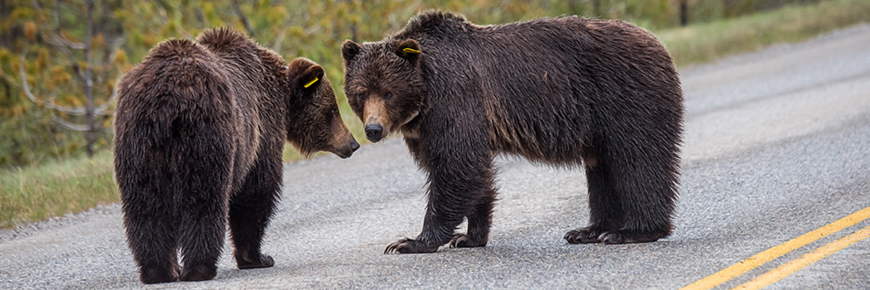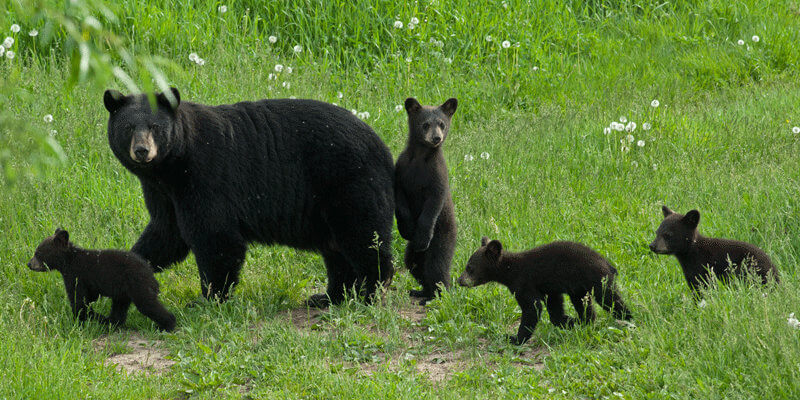Bear encounters in the great outdoors
Bear encounters are an ever-present possibility just about wherever you go in the Columbia Valley. We share our space with the black bear and the grizzly, which are the species that make their homes in our area, and it is our responsibility and challenge to live respectfully and recreate in harmony with these wilderness animals.
We spend more hours out-of-doors in summer. We hike, we bike, we camp and generally spend more time in areas where bear encounters are most likely to occur. Bears are mostly nocturnal, but in the early spring they search for food almost constantly and so are commonly seen in the daytime. And as winter approaches they spend up to 20 hours a day foraging for food. Thus daytime meet-ups with bears are most likely in early spring and in the late summer and fall.
For many people, especially if they live in urban areas far from the possibility of any bear encounters, the only thing they ‘know’ is what they’ve heard from the nightly news reports of human/bear conflicts with tragic outcomes. Sad as the stories are, it is a truth that many of those tragic outcomes could have been prevented if the humans involved had some knowledge about bears and how to avoid possible conflicts in the wilderness.
So how can we do all the fun outdoor things we love to do in this beautiful mountain valley and still be safe? To begin with, lets take a look at a few basic facts about black bears and grizzlies, because the two species are different in many ways.

Black Bears:
- This species is mostly found in areas where there is a large enough undisturbed forest cover to provide food and shelter.
- Black bears are usually smaller than grizzlies and generally solitary creatures, except for mothers with cubs. They are also more timid and their prime means of defense is to climb trees — they are usually more afraid of you than you are of them!
- They are wary of predators like grizzlies, other black bears and wolves, but their biggest threats are the results of human decisions and behavior. Of course hunting comes to mind, however the construction of roads, towns, recreational endeavors, etc. all fragment their habitat, destroying their travel corridors, their shelter and in many cases wiping out large areas which previously had been sources of food.
- For black bears, motor vehicle collisions are the leading cause of human-caused mortality in the mountain parks. There is even an 11 km No Stopping Zone on Highway 93 coming through Kootenay National Park, to help minimize this danger during the ‘bear season’. Why? Because humans often foolishly stop when they see a bear feeding beside the road. Many of them will get out of their cars to take pictures or offer food to the animals (against the law). Poor decisions like this not only put the humans themselves at risk, but also the animals and other vehicles on the highway. Although fun to watch, bears are not the cute, cuddly animals of childhood tales. They are potentially dangerous wherever you encounter them!
- They are omnivores. Although 85% of their diet is plants, black bears do eat some meat (ants are a favorite treat). They are also scavengers, seeking whatever food they can find. This is why so many black bears find their way into communities and campgrounds where humans have left remains from barbecues or picnic lunches, or where ripened tree fruit is lying on the ground. They will go after anything with a scent which the bear could mistake as food.
- Once they become habituated in this way, black bears will keep returning to the places where they have found food in the past.

Grizzlies
- In British Columbia, the grizzly bear is blue-listed (“vulnerable in their locale”).
- Within the bounds of Kootenay National Park there are an estimated 9-16 grizzlies (Note: many of these bears are traveling through the area in search of food and do not spend their entire lives within the park).
- Habitat loss and fragmentation as the human population increases is a major threat to grizzly survival, as are human/grizzly collisions on roads and highways.
- Grizzlies can live 20 to 30 years but most die human-caused deaths much younger than that. Offspring remain with their mothers for 3 years.
- Grizzly bears have a distinctive hump at the shoulders that other species do not have. They also have an excellent sense of smell, good eyesight and hearing.
- Grizzlies would prefer not to encounter humans but some are courageous and will risk human encounters to seek food alongside roadways.
- They are classified as carnivores but are actually omnivores, foraging for vegetation when it’s available and preying upon newborn calves and offspring of elk, deer, etc. They will sometimes even eat their own young.
- Their food sources are scattered and they have to travel widely to find enough to keep them nourished through their six-month hibernation period.
- Grizzly bears are solitary animals, except when with offspring or a mate.
- Young grizzlies are curious creatures, seeking food sources in many places as they learn how to survive on their own. They are naïve and often tolerate people in order to find good quality habitat around human developments. They become bolder or less wary around people and are more likely to die a human-caused death.
- Female grizzlies will also seek food sources for their young and protection for them from male grizzlies around human establishments.

Reducing human-bear conflicts
Remember, bears will go out of their way to avoid us if possible. They want an encounter with us less than we do! Although fun to watch, bears are not the cute, cuddly animals of childhood tales. They are potentially dangerous wherever you encounter them!
Here are some things that you can do to minimize the risk of a bear encounter while you are enjoying your outdoor adventure:
- Before you leave home, read everything you can get your hands on to learn about bear encounters in the great outdoors and make sure everyone in your party becomes informed as well. An excellent book you may wish to read is Bears Without Fear by Kevin Van Tighem. There is a good review of it here with links to various booksellers who carry the book: http://www.rmbooks.com/book_details.php?isbn_upc=9781927330319
- Most tourist information centres have brochures, booklets, etc. and there’s lots of good information at http://www2.gov.bc.ca/gov/content/environment/plants-animals-ecosystems/wildlife/human-wildlife-conflict and on Bear Smart’s website at http://bearsmart.com/about-bears/know-the-difference/
- Check here to see if there have been any reported bear sightings in the area where you plan to be going: http://www.pc.gc.ca/en/pn-np/mtn/ours-bears/miseajour-update/miseajour-update-byk
- Leave your trip plans, schedule and expected location with someone at home.
- Carry bear spray and bear bangers and make sure you know how to use them! — see videos at end the of this article. Carry in an easily accessible place on your person ( your backpack is not a good choice in an emergency!).
- The best time of day to avoid bears is broad daylight.
- Don’t go alone. The larger the group, the safer you generally will be.
- Keep small children close at all times.
- If you are taking your dog, keep it on a leash at all times (if you are camping overnight, do not leave the dog outside at night).
- Make lots of noise! Laughing, talking loudly, singing, a noisemaker such as bear bells or a bear banger will usually keep bears at a distance.
- Watch for fresh signs of bear activity such as droppings and swarming scavenger birds (an indication of a fresh kill).
What to do if you come face to face with a bear
If you do meet up with a bear, it will likely be as surprised as you are. People who have prepared themselves for a possible encounter by learning as much as they can ahead of time, are less likely to panic, scaring the bear and instigating an out-and-out conflict.
Here’s what you can do if you come face to face with one on the trail:
- Perhaps the most important thing to remember and the most difficult thing to actually do is to stay calm!
- Now would be a good time to remember you have your bear spray in your hand. Sometimes panic will make you forget you even have it.
- Look around for cubs or a freshly killed carcass. Bears will more aggressively protect these.
- Don’t yell at the bear but talk to it in a soft, soothing voice so it doesn’t get any enemy vibes from you.
- Slowly back up the way you came, always keeping your eye on what the bear is doing.
- If you have no choice but to move forward, make as wide a circle around the bear as you possibly can.
- Look for a place of safety. That doesn’t include climbing a tree because the bear can climb faster and better than you can!

